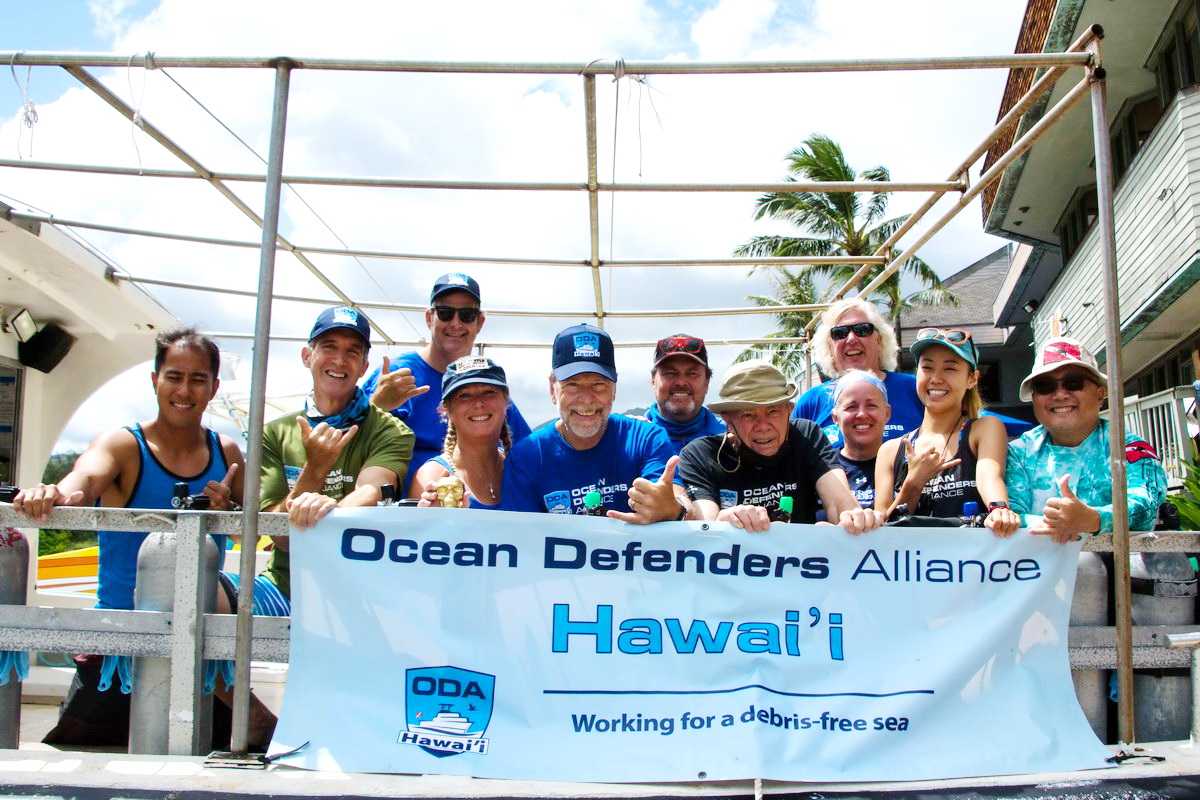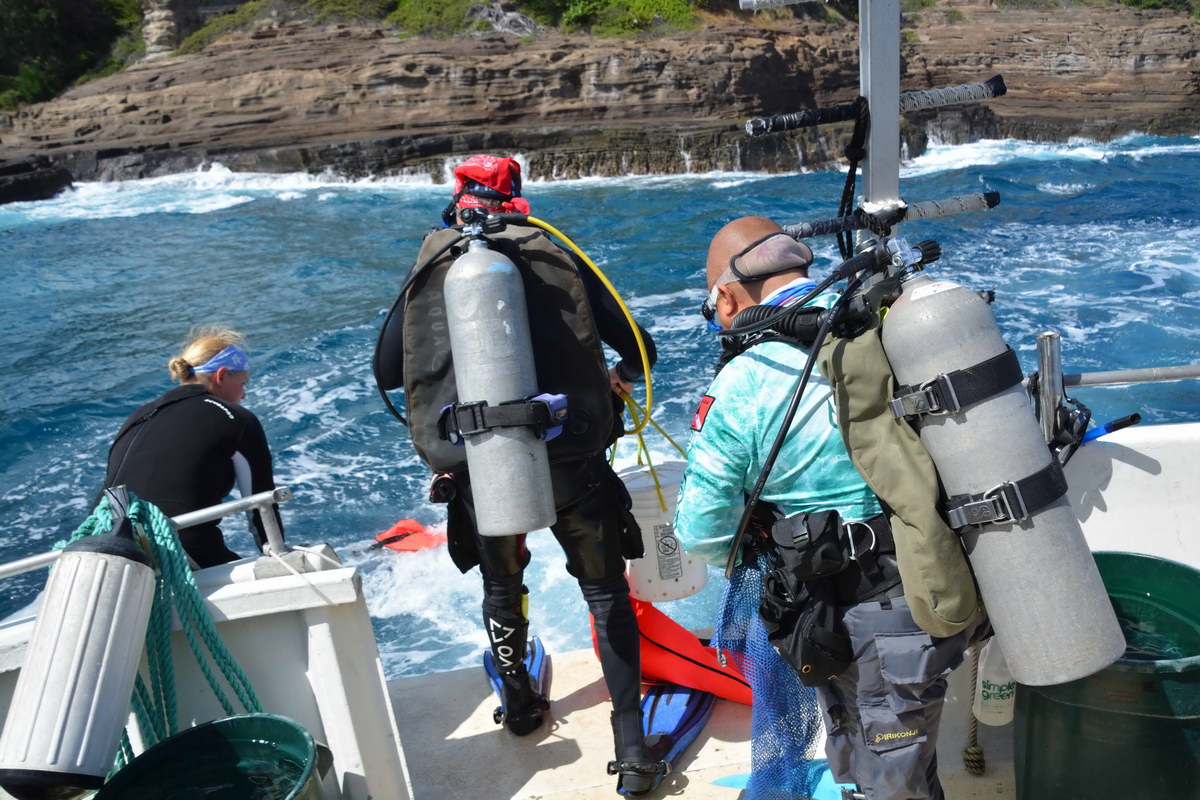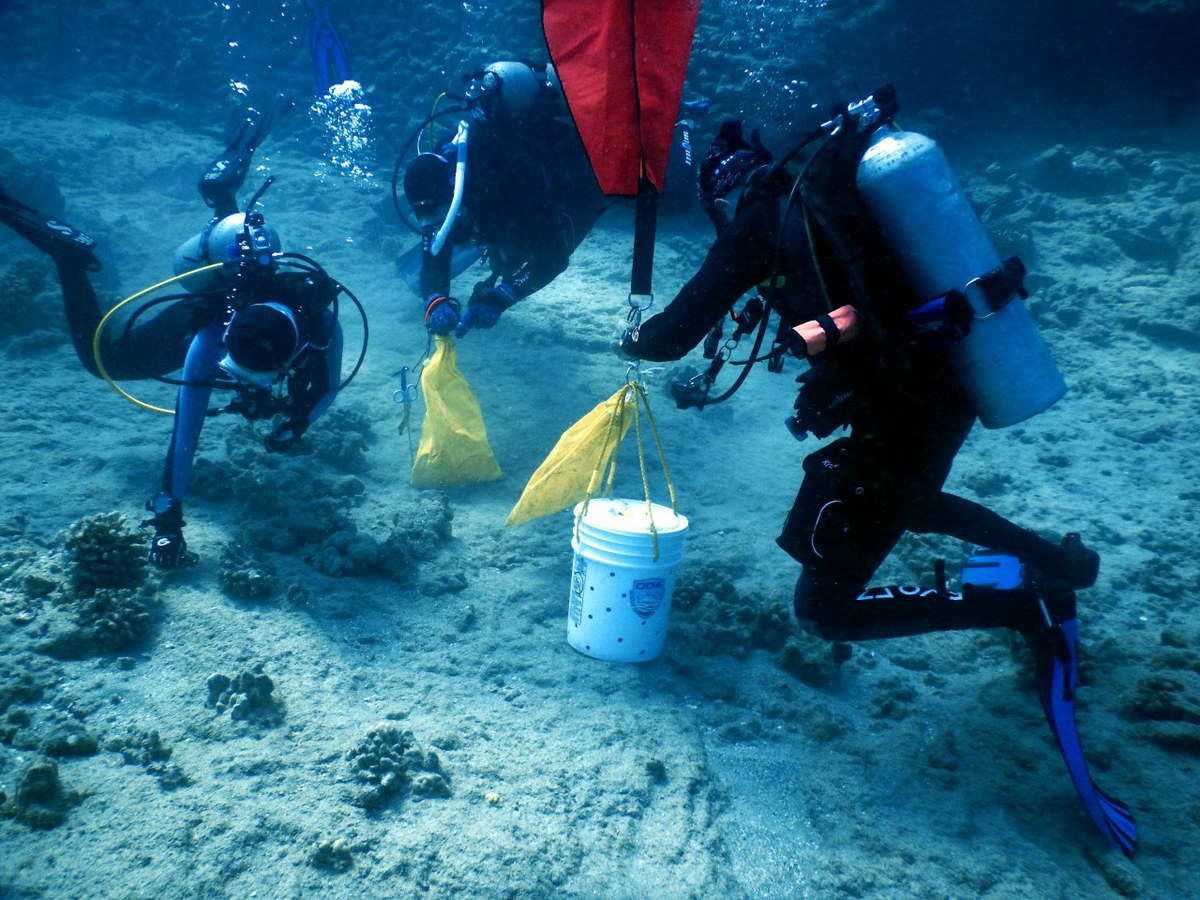By Founder and President Kurt Lieber
As we were starting to put Covid-19 restrictions behind us on the Mainland of the US, I was chomping at the bit to get back to Hawai’i, to our ODA chapter there. I hadn't been to the islands since January of 2020 and was anxious to take part in and restart some vital programs there. As soon as I felt it was safe enough to travel, I booked a flight that would take me to Oahu, and then on to the Big Island.
First Stop – Kaneohe Bay
I landed in Honolulu on Thursday, May 13th. The very next day, Friday, I met with ODA-Hawai’i Coordinators and Advisory Board Members Ken Staples and Glenn Roberts, who had arranged a meeting between the three of us and Tanya Borabora. Tanya is the harbormaster on the east side of the Oahu and oversees a huge expanse of water called Kaneohe Bay, where there’s lot of boating and fishing activity.
 Ko'olau Range and Kaneohe Bay, courtesy Wikimedia Commons
Ko'olau Range and Kaneohe Bay, courtesy Wikimedia Commons
We had a great talk and decided that we’d like to help by doing underwater cleanups around the entire bay. This part of Oahu is unique because there are several different species of coral that are thriving here, despite the warming waters and the waters not being very clear due to it being shallow water with a lot of suspended particles in the water. Corals need clear water to grow, and the corals here don’t get that, so studies are underway to help understand this phenomenon. The University of Hawai’i sends instructors and students to the site, where they have ongoing studies looking at the health of the corals as well as the fish community.
Because we are specialists at removing marine debris and have experience cleaning up harbors, Tanya felt that ODA would be the perfect organization to clean up the Bay. Ken and Glenn are going to meet with her early in June to go out in a boat and examine several sites that need our expert help.
This is a really an exciting opportunity for us as it allows us to expand our operations in Hawai’i, and because the water is so shallow, we can use divers who don’t necessarily have the high level skills that some of our other projects require.
Next up - Hanauma Bay Marine Preserve
On Saturday, I was invited to meet with two ladies who are very involved with Hanauma Bay Marine Preserve: Lynette Liu and Lisa Bishop. Lynette oversees the entire operations of the Bay. Lisa runs a nonprofit organization that’s dedicated to protecting the Bay’s natural resources. Her group is called Friends of Hanauma Bay.
Lisa and I talked for over an hour. She filled me in on several of the issues they’re working on to enhance and preserve the corals and fish that call this protected area home. Several ODA divers have been helping with the studies on the health of the corals and Lisa was very grateful for our efforts. Ken Staples, Cindy Staples, Glenn Roberts, and Anke Roberts have participated in several of these citizen science dives.
 Cindy, Ken, and Glenn on one of those citizen science projects
Cindy, Ken, and Glenn on one of those citizen science projects
Lisa also talked extensively about the issue of sunscreens and the effects the toxins in them are having not only on the corals but on the clarity of the water itself. In years past, the water was so cloudy that you would have difficulty seeing people’s fins in the water, even though you could see their sunburnt backsides.
As you can see from this picture, the water quality has vastly improved since they banned certain sunscreens from being used.
Lisa: Thanks for the tour, AND all you are doing for this world-renowned marine park! Lynette: Thank you for your time; we’re honored to work in this magnificent place you manage so well! And our gratitude goes to Anke Roberts for setting up the meeting and taking these pictures.
Monthly Cleanup with IDH
On Sunday, May 16th, several of us boarded our partner Island Divers Hawaii's (IDH) boat late in the afternoon and headed out to sea with eight scuba divers and two crew members. It was like a family reunion, as I've known a lot of these people for six years. It's fun to get to see them again as well as energizing to reflect on all the work they’ve accomplished since I was last there 14 months ago.
The divers this day were Glenn Roberts, Dan Okamura, Marjorie and Mark Taylor, Matt Zimmerman (IDH owner), Rose Zang, and Alan.
The winds and waves were making this look like a very iffy day for diving. We weren't even sure we were going to be able to get in the water. The winds were blowing pretty hard at 40 miles-an-hour and there were white caps as far as the eye could see.
But we headed out just to give it a shot. Between Matt and Captain Tim they found a sweet spot where the water looked relatively calm at the surface, and we successfully dropped all the divers at spot known as China Walls.
It was fun to see how efficient these divers were. Once they got the “go ahead” all of them were in the water within three minutes. They looked like paratroopers jumping out of a plane!

After they hit the water, they descended very quickly. Tim motored the boat where we could see the divers’ bubbles and kept a safe distance from them. Tim and I patiently waited and watched for the next 40 minutes.
And sure enough at the end of 40 minutes they all surfaced at once and we picked them up without a hitch. As they all climbed on board, we could see that they had quite a bit of fishing lines and lead weights in their collection buckets.
Once everybody was back on board and out of their gear, I started talking to them to find out what they had seen. Matt found a turtle that had fishing line wrapped all around its head and one of its front flippers. He showed me some video he was able to take, and you could clearly see the flipper was becoming infected. They tried to catch the animal to untangle it but it was just too fast and determined to get away from those huge “things” with huge bursts of bubbles coming out of their mouths…
It turns out the visibility was really good at about 50', but the surge was so strong that they were afraid to get close to the surface where a lot of the fishing line was. So they stayed down in the 40' range to stay out of that surge zone. While they didn't come up with as much as they usually do on these types of dives, they still got about 900 feet of fishing line. We don’t want to see any more turtles getting entangled in this nasty stuff.
Any bit of fishing line they remove is a huge benefit to the wildlife, as you never know what fish or turtle is going to succumb to the injuries that this gear inflicts on them.
The only bummer about the day was that Ken Staples couldn't make it. He had gotten an ear infection the night before and divers cannot dive with a swollen ear canal.
Much to be Grateful for…
As the day wound down, I thought about the fact that Ken and Glenn have been leading these dives as well as beach cleanups for years now and are doing such an excellent job. ODA is fortunate to have them! I was also really impressed with the quality of divers who helped out this day. It was great to be back in Hawai’i – it’s beautiful for sure, but the best part was seeing so many smiling faces on that boat, knowing we’re doing our part to make the oceans safer for all forms of wildlife and keeping Hawai’i beautiful and free of debris!
Want to hear more about our work in Hanauma Bay? Check out this citizen science work we did along with some pretty pictures!
https://www.oceandefenders.org/news-and-media/partnership-scientific-studies-with-friends-of-hanauma-bay.html








